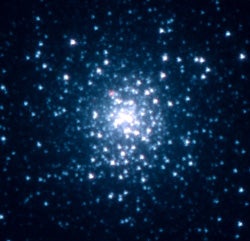The dust that condensed to form the sun, the Earth and the stuff of human bodies has long been thought to have originated in violent explosions of giant stars. But these explosions–called supernovae–can’t account for all the dust in the cosmos. Now, observations with NASA’s Spitzer Space Telescope, led by University of Minnesota astrophysicists, have found cosmic dust where it had never been found before. The finding implies that the deaths of smaller, humbler stars may have supplied the early dust that seeded the myriad stars like our sun, and produced dust more efficiently than the big guns. The work is published in the October issue of the Astrophysical Journal.
Led by the university’s Martha Boyer, a graduate student in astronomy, and astronomy professor Charles “Chick” Woodward, the research team found dust deep within an ancient pack of stars called a globular cluster. Known by its astronomical designation M15, the cluster contains hundreds of thousands of stars and is probably 12.5 billion years old, dating back to the early days of our Milky Way galaxy. Its stars are similar to the sun, but some of them are undergoing the death throes that the sun will experience one day. In that process, the stars swell up into huge, relatively cool stars known as red giants and give off a strong stellar wind containing the seeds of dust grains.
Most surprising about the find was that so much dust could have formed in M15 even though its stars contain very few metals. (In astronomy, “metals” are elements heavier than hydrogen and helium, the two lightest elements.) Metals like carbon, oxygen and nitrogen are necessary for forming the nuclei of small particles on which silicon and other elements can condense to form dust grains. But the ancient stars of M15 may be models of what the first stars in the universe were like. They contain mostly the primordial elements hydrogen and helium, which have not yet combined to form very much of the heavier metallic elements.
In stars with higher metal contents, carbon and oxygen often combine on the outer surface of the star to form carbon monoxide, a gas. But, in the metal-poor stars of M15, it could be that a lack of oxygen on the surface leaves more carbon free to form dust particles.
“Our work with globular clusters may show that dust can be made
efficiently by these ordinary stars, even though they lack heavy metals,” said Boyer. “Then, perhaps, this dust combines with interstellar gas to form new stars and planets. About 13 billion years ago, most stars may have been like these, only not in clusters but everywhere, spewing out dust when they got old and turned into red giants.”
According to Boyer, when new stars with solar systems form, they may be polluted by material ejected into space from both supernovae and ordinary stars like those of M15.
“These small stars are the majority of stars in the universe, in terms of
both mass and numbers,” she said. “That’s why it’s important to know that they make so much dust. They’re probably major contributors.”
Researchers from the University of Keele, U.K., and the University of Arizona also contributed to the study. The work was supported by NASA.










